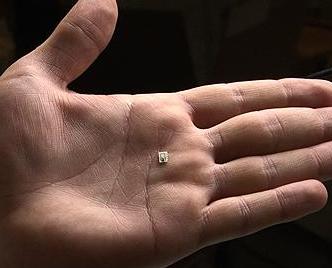Wireless self-propelled chip swims through blood vessels
28 February 2012
A tiny, wirelessly powered, self-propelled medical device capable of controlled motion through blood vessels has been developed by electrical engineers at Stanford University.
The device, which looks like a tiny circuit board 3x4mm, is powered wirelessly by radio waves and can be injected or implanted in the body. A radio transmitter outside the body sends signals inside the body to an independent device that picks up the signal with an antenna of coiled wire.
The transmitter and the antennae are magnetically coupled such that any change in current flow in the transmitter induces a voltage in the other wire. The power can be used to run electronics on the device and propel it through the bloodstream.

The current prototype of the radio-powered self-propelled chip
Developed by Ada Poon, assistant professor of electrical engineering at Stanford, the device has the potential to to deliver drugs, perform analyses, remove blood clots or remove plaque from arteries.
Team member Teresa Meng, a professor of electrical engineering and computer science, said, "While we have gotten very good at shrinking electronic and mechanical components of implants, energy storage has lagged in the move to miniaturize. This hinders us in where we can place implants within the body and also creates the risk of corrosion or broken wires, not to mention replacing aging batteries."

Professor Ada Poon (right) holding the chip in
a dish, with graduate students Daniel Pivonka (left) and Anatoly
Yakovlev (centre).
The key to creating the battery-less device was rethinking old assumptions about dissipation of radio waves in the human body. Professor Poon realized that scientists had been approaching the problem incorrectly in assuming that human muscle, fat and bone were generally good conductors of electricity. She modelled tissue as a dielectric — a type of insulator and also discovered that human tissue is a "low-loss" dielectric which means radio waves travel much farther in human tissue than originally thought.
"When we extended things to higher frequencies using a simple model of tissue, we realized that the optimal frequency for wireless powering is actually around one gigahertz," said Poon, "about 100 times higher than previously thought."
More significantly, however, her revelation meant that antennae inside the body could be 100 times smaller and yet deliver the power needed by the medical device. The antenna on the device is just 2 millimetres square, small enough to travel through the bloodstream.
She has developed two types of self-propelled devices. One drives electrical current directly through the fluid to create a directional force that pushes the device forward. This type of device is capable of moving at just over half-a-centimetre per second. The second type switches current back-and-forth through a wire loop to produce a swishing motion similar to the motion a kayaker makes to paddle upstream.
"There is considerable room for improvement and much work remains before such devices are ready for medical applications," said Poon. "But for the first time in decades the possibility seems closer than ever."
Stanford researchers explain how the chip works.